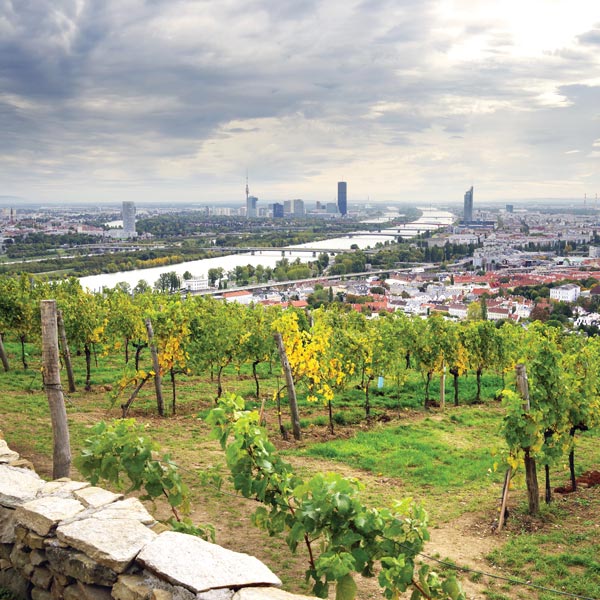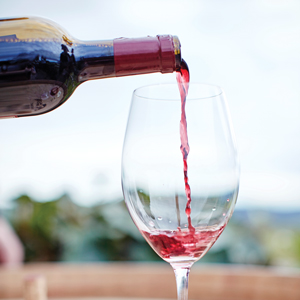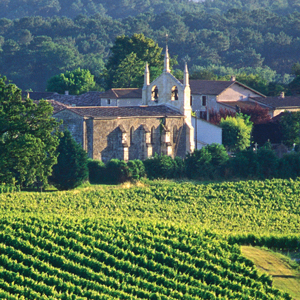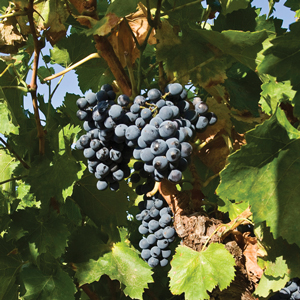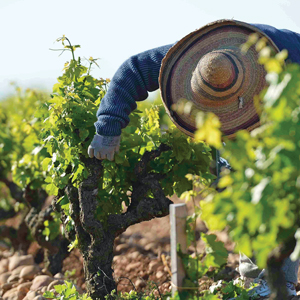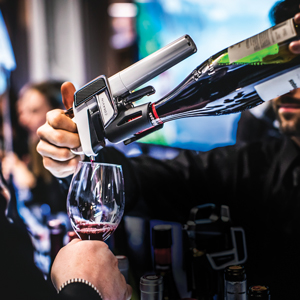SOMM360 is a platform for every sommelier seeking perfection through continuous education and training for competition.
Get the latest info about Somm360
© 2018 SOMM360



austria
beyond
Grüner
veltlineR
Wines of Austria impressed the sommeliers at the SOMM360 conference with their presentation. Many of the participants were unaware of the great diversity of indigenous grape varieties, the distinctive terroirs and the rapid evolution of this exceptional wine country.
Christian Zechmeister and Katja Scharnagl
The master class on Austrian wines, given by Christian Zechmeister and Katja Scharnagl, focused on the country’s lesser-known indigenous grape varieties. Both speakers grew up immersed in the Austrian wine world. Christian is director of Wein Burgenland, and Katja is head sommelier at Le Bernardin restaurant in New York City. And if Austria is renowned for its excellent Grüner Veltliner, the message in Montreal was that some of Austria’s rarely used, lesser-known indigenous varieties can be stars in their own right.
Austrian wines are world-renowned, even if the country accounts for less than one percent of the global wine portfolio. Wine production in Austria could almost be described as artisanal, since it is practised on such a small scale: the average winery size is only about 3.22 hectares. But its superior quality makes up for its modest quantity. The country continues to move toward organic production or minimum intervention: 14.2 percent of its wines are organic and 79 percent are crafted with minimal intervention.
Lower Austria: Neuburger
While the mountains and ski resorts Austria is famous for are found in the west, its wine-producing regions are all located in the east. There are basically four wine-growing regions: Niederösterreich (Lower Austria), Steiermark (Styria), Burgenland and Wien (Vienna). These generic regions comprise several smaller specified wine-growing regions, for example Wachau or Weinviertel in Niederösterreich, Neusiedlersee in Burgenland or Südsteiermark in Steiermark.
Lower Austria is the largest wine-growing region, with 60 percent of the country’s vineyards. There, the Wachau region is located along the narrowest part of the Danube River. This is home terrain for Neuburger, a unique indigenous grape variety. It has a reputation as a bit of a vineyard diva, difficult to master; there are fewer than 500 hectares of Neuburger planted throughout Austria. In Wachau, it is mostly grown in the cooler zones of the steeply inclined hillside terraces where the famous Grüner Veltliner or Riesling don’t do as well. It is in these narrow river valleys that the colder air from Austria’s northern region combines with the terroir to produce ideal conditions for Neuburger. Sommelier Katja Scharnagl says the result is a robust, full-bodied but light wine, which can be served alone and also goes well with seafood or a fish dish.
Lower Austria: Roter Veltliner
Another, even rarer, indigenous variety found in Lower Austria is Roter Veltliner. Although there are only 195 hectares planted, it is the parent variety of the Veltliner group and appears in numerous native varieties, including Neuburger, Rotgipfler and Zierfandler. The vineyards around Deutsch-Wagram are dominated by loess, a calcareous-dolomitic rock that can sometimes reach 15 to 20 metres deep. “Few winemakers in Austria choose to work with Roter Veltliner, because the results can be so unpredictable. Because it is such a high-yielding variety, reducing the yield is crucial for the production of top quality wines,” explained Christian Zechmeister. Tasting several wines during the master class, the participants at SOMM360 found that, at its best, Roter Veltliner can result in a powerful wine with aristocratic aromas full of fruit, with notes of red and green apple, zesty and dry with a long aging potential. Sommelier Katja Scharnagl explained that it can be sold by the glass or paired with meat, cream-based pasta and other heavier dishes.
The Thermenregion: Rotgipfler and Zierfandler
The towns of Baden bei Wien and Gumpoldskirchen in the Thermenregion (south of the capital, Vienna) are famous for their thermal hot springs. This is the only region where two unique indigenous grape varieties can be found: Rotgipfler (170 hectares) and Zierfandler (77 hectares). The two are usually blended. The result is a rare, exciting wine with exotic flavours of rich yellow fruit that perfectly balances high residual sugar content with its acidity. For the conference speaker Christian Zechmeister, it pairs well with Asian or spicy dishes, zesty fish preparations or even fried chicken, and this wine is considered extremely rare, and very little is exported, making it even more unique.
Vienna: Wiener Gemischter Satz
The capital city of Vienna is home to more than 600 hectares of vineyards, making it the only European capital with an active wine industry within its borders. The city is dominated by white wines: Grüner Veltliner, Riesling and Chardonnay. But if there is one wine style that defines Vienna, it is Wiener Gemischter Satz, loosely translated as the Viennese field blend. That means at least three different white varieties are planted in the same vineyard and harvested together. The result is a distinctive Viennese style, always fresh and fruity. It pairs perfectly with classic Viennese dishes such as Wiener schnitzel or sausages which are served in the local wine taverns known as Heurigen. But the best Gemischter Satz wines can easily be paired with haute cuisine. Vienna in a glass!
Styria: Weststeiermark
In Styria, the southernmost wine-growing region of Austria, a spicy rosé called Schilcher dominates the scene, a truly distinctive terroir wine. These rosés are found almost exclusively in the Weststeiermark region of Styria, where the geology consists mainly of old metamorphic rock and where the rainfall tends to be higher than in most of Austria. The Schilcher rosé is made with Blauer Wildbacher, a relative of Blaufränkisch. While it was originally considered a peasant wine, in recent years, winemakers have transformed Schilcher into an internationally sought-after terroir wine, unique to Austria.
“If Austria is renowned for its excellent Grüner Veltliner, the message at SOMM360 was that some of Austria’s rarely used, lesser-known indigenous varieties can be stars in their own right.”
The Nussberg vineyard in Vienna
Austria’s Reds
Austria may be white-wine country, but there are also indigenous red varietals, including Zweigelt, Sankt Laurent and Blaufränkisch. Most of the reds are produced in an area southeast of Vienna, where the continental Pannonian climate blowing in from Hungary is strongest. The Pannonian climate means warm summers with 2,000 hours of sunshine and cold, dry winters.
Zweigelt thrives in the Carnuntum region of Lower Austria, which stretches from Vienna to the eastern border with Slovakia. This varietal is relatively young: a crossing between Blaufränkisch and Sankt Laurent from the 1920s. In recent years, winemakers have greatly reduced the yield by green harvesting in order to increase the quality of the wine. Zweigelt can be drunk just a few months after harvest, but it also has excellent aging potential. “With its dark ruby colour, juicy cherry on the palate and a long-lasting structure, it should be served slightly chilled with grilled meat or fish or with ripe cheese with nuts,” sommelier Katja Scharnagl told the audience.
The indigenous Sankt Laurent variety belongs to the Pinot family and is sometimes referred to as the Austrian Pinot Noir. Like the Pinot Noir, it is considered difficult in the vineyard because its yields vary widely and because it is prone to fungus. If it rains in September during harvest, winemakers can lose much of their crop. But Sankt Laurent does well in the Thermenregion and in northern Burgenland. It is often planted near the shores of Lake Neusiedl, a shallow steppe lake with a microclimate that absorbs the sunlight during the day and releases it at night. “But if Sankt Laurent is considered a diva in the vineyard, it rewards winemakers by delivering dark, sturdy, fruity and piquant red wines with notes of cherry that age well,” wine expert Christian Zechmeister assured the industry audience at SOMM360.
“While the mountains and ski resorts Austria is famous for are found in the west, its wine-producing regions are all located in the east. There are basically four wine-growing regions: Niederösterreich (Lower Austria), Steiermark (Styria), Burgenland and Wien (Vienna). These generic regions comprise several smaller specified wine-growing regions, for example Wachau or Weinviertel in Niederösterreich, Neusiedlersee in Burgenland or Südsteiermark in Steiermark.”
Blaufränkisch Wines
The Blaufränkisch grape was first documented in the 18th Century in Austria. It has been used as a crossing partner for new Austrian breeds such as Zweigelt, Blauburger, Roesler and Rathay (or Ráthay). “Blaufränkisch needs time in the vineyard, in the cellar and in the bottle. It can easily spend two or three years in the cellar and has great aging potential,” explains Christian Zechmeister. It thrives in the vineyards of Burgenland, with their soils ranging from heavy—sometimes ferrous—loam and sandy gravel to limestone and slate. The late-ripening variety is characterized by tones of berry and cherry and has a refreshing acidity. It is very versatile since it pairs well with all kinds of meats.
If the Grüner Veltliner grape variety is now considered one of the great white wines of the world, Austria boasts many unique indigenous varietals which help to reflect the country’s wine regions and terroirs and offer so many possibilities for today’s young, adventurous winemakers. The fact that production is often on such a small scale makes these wines even more special!
Share this article:










